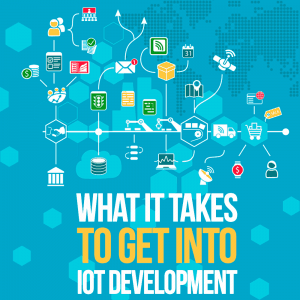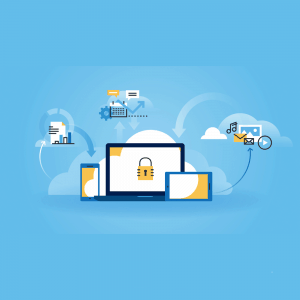 In 2015, there were 15.4 billion internet-connected devices, and that number is expected to grow to 30.7 billion by 2020 and 75.4 billion by 2025. As the demand for “internet of things” (IoT) devices and technologies continues to climb, so will the need for developers and experienced coders who can help maintain and deliver these systems.
In 2015, there were 15.4 billion internet-connected devices, and that number is expected to grow to 30.7 billion by 2020 and 75.4 billion by 2025. As the demand for “internet of things” (IoT) devices and technologies continues to climb, so will the need for developers and experienced coders who can help maintain and deliver these systems.
But it's not just the consumer space that's burgeoning: it's nearly every industry, including manufacturing, medical, military, and retail. SparkLabs predicts that the market will expand from 2.5 billion connections in 2017 to 5.4 billion in 2020.
Now is as great a time as any to climb aboard if you’re considering a career in IoT development.
To be successful as an IoT developer, you will need to build a diverse set of skills and talents. More importantly, you will need to become familiar with several programming languages, including Assembly, B#, C, GO, Java, Python, PHP, Swift, and several others. Of course, the exact language depends on the platform and software you will be working with.
That said, the need for programming experience is obvious. So what else does it take to break into the IoT development sector?
For IoT, the necessary concepts and skills can be broken down into six major categories.
1. Hardware
The internet of things relates to the connection between devices and the virtual world. Smart devices, such as the Google Home everybody got for Christmas, the gamified toothbrush your kids are now using, and even that smartphone-controlled coffee machine, often include physical sensors and connectors that are used to measure physical elements. This is turned into data, fed back into the device and onto the “connected” space, otherwise known as the internet.
Therefore, the hardware behind IoT is just as essential as the software facilitating the data collection and transfer.
As an IoT developer, it's in your best interest to study and understand the various devices you will be creating applications and software for. While not every IoT device is the same, it’s important to familiarize yourself with the ways the product interacts with the consumer and the consumer interacts with the product.
2. Networking
Connectivity, or networking, is one of the most crucial components of IoT devices. It's what allows the devices to communicate with one another via applications, services, and cloud technologies.
You will need at least a basic understanding of network design and management, as well as a grasp on standards and protocols used in networking. To rattle off a few, there's Wi-Fi, Bluetooth, radio-frequency identification (RFID), Zigbee, and many others.
While there are multiple books on the subject of getting started in IoT development, not everyone might be able to grasp the knowledge on their own. For those who learn better with some guidance, online courses–such as the one offered by Coursera–are a great place to get some solid foundational knowledge.
3. Application Design and Development
Web and mobile applications are the user-centric portals for interacting with IoT devices and networks. If you are developing a smart bulb, for example, you also need to design a mobile app that allows consumers to use the bulb. This requires working knowledge of not only software development and design, but also user interface (UI) and user experience (UX) design skills.
Some of the newer IoT devices employ proprietary user interfaces, such as voice control systems, like Amazon's Alexa. When working with these gadgets, you'll need to understand and be able to work with the UI in question since each device can differ on which language they favor.
4. Security
Because IoT devices connect to the internet and network with nearby devices, security is a primary concern. In fact, security has been one of the biggest hurdles when it comes to the adoption of IoT, as these devices’ intimate relationship with users’ everyday lives ends with an abundance of collected data.

Data ethics, privacy, and liability also fall into this category and can come with legal repercussions should you fail to follow through with them. As a developer, you'll need to remain on the cutting edge regarding security measures.
5. Business Intelligence and Data Analytics
IoT is not just a consumer-focused movement. It's taking hold in nearly all facets of business.
As a developer, you'll need to understand how companies can make use of modern IoT devices to collect data (which, based on the device’s context and sensors, can include anything from location, to TV-viewing habits, to heart rate) and be familiar with the data science-side of the equation.
How can you reliably receive, process, and store data and then make use of it later? You'll need to be able to develop and create systems that can help with the data processing, which are both reliable and accurate. That alone requires a deep understanding of business intelligence and how modern analytics tools work.
While it is very much possible to teach yourself about big data’s role in IoT and how to develop with that in mind, edX offers a great course on IoT programming and big data.
6. Machine Learning and Artificial Intelligence
While not all IoT devices and hardware utilize machine learning, it's something you should be familiar with anyway. You should at least understand how developers use the technology to enhance IoT devices.
Machine learning is an application of artificial intelligence that involves providing computers with access to data and letting them use it to learn. Through machine learning, algorithms have taught themselves how to play board games, recognize abnormalities in X-rays, and perform many other complex tasks.
Because IoT devices gather so much data, they have tremendous potential regarding machine learning. IBM recently unveiled plans for making IoT the “internet that thinks” with Watson IoT, and there is already talk that machine learning and IoT devices will be able to help the smart cities of the future discover the preconditions of accidents and crimes.
IBM and digital justice aside, much like in other fields and industries, machine learning is being used to help turn using an IoT device into a more personalized experience for the consumer. Nest thermostats already learn users’ temperature preferences.
How Do I Become an IoT Developer?
If you already have your foot in the door, then you likely have an idea of where to go next. But if you’re starting from scratch, there’s a lot here to digest. Where is the best place to start? Where can you go to learn?
The best answer is wherever you feel comfortable. As you can see from the list above, you'll need to know about nearly all facets of technology as an IoT developer, including software, hardware, and everything in-between. You can't go wrong with a solid programming or development background, so it's a great idea to start there. Do some research on the IoT systems you'd like to work with and find the common language.
In the meantime, you can also tinker with beginner or starter sets using Arduino and Raspberry Pi builds. They allow you to build and develop your own IoT systems and hardware–and it's quite fun too.
With the advice given above, and a little of your own research and experimenting, the jump to becoming an IoT developer isn’t as far away as you might have originally thought.
Now go–become the IoT developer that our connected world needs! You know we’re all waiting for that new voice-activated yo-yo that’s able to track your steps, pay your bills, and order an Uber.
